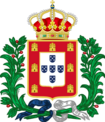
The title Duke of Braganza in the House of Braganza is one of the most important titles in the peerage of Portugal. Starting in 1640, when the House of Braganza acceded to the throne of Portugal, the male heir of the Portuguese Crown were known as Duke of Braganza, along with their style Prince of Beira or Prince of Brazil. The tradition of the heir to the throne being titled Duke of Braganza was revived by various pretenders after the establishment of the Portuguese Republic on 5 October 1910 to signify their claims to the throne.

The Most Serene House of Braganza, also known as the Brigantine dynasty, is a dynasty of emperors, kings, princes, and dukes of Portuguese origin which reigned in Europe and the Americas.
Infante, also anglicised as "infant" or translated as "prince", is the title and rank given in the Iberian kingdoms of Spain and Portugal to the sons and daughters (infantas) of the king, regardless of age, sometimes with the exception of the heir apparent or heir presumptive to the throne who usually bears a unique princely or ducal title. A woman married to a male infante was accorded the title of infanta if the marriage was dynastically approved, although since 1987 this is no longer automatically the case in Spain. Husbands of born infantas did not obtain the title of infante through marriage, although they were occasionally elevated to the title de gracia at the sovereign's command.

The House of Leszczyński was a prominent Polish noble family. They were magnates in the Polish–Lithuanian Commonwealth and later became royal family of Poland.
This is a list of Princesses of Brazil, from 1645 to 1815, both by marriage and birth. The title was preceded by the titles Princess of Portugal and succeeded by Princess Royal of Portugal.

Don Teodósio, Prince of Brazil, Duke of Braganza was the heir apparent son of John IV of Portugal and his wife Luisa de Guzmán. In 1645, he was given the title of Prince of Brazil, a new crown princely position thus created. Also, his father granted him the duchy as 10th Duke of Braganza, presumably after his uncle Duarte died in 1649.
Isabella of Portugal (1503–1539). was Holy Roman Empress and Queen of Spain as the wife of Charles V & I.

DomSebastian Gabriel de Borbón y Braganza, Infante of Portugal and Spain, was an Iberian prince of the 19th century, progenitor of the Spanish ducal lines of Hernani, Ansola, Dúrcal and Marchena, and Carlist army commander in the First Carlist War.

Michel de Ligne, 14th Prince de Ligne, Prince d'Épinoy, Prince d'Amblise, GE is the head of the princely House of Ligne. He is the eldest son of Antoine, 13th Prince de Ligne, and his wife, Princess Alix of Luxembourg; he is thus a nephew of the late Jean, Grand Duke of Luxembourg, and a cousin of reigning Grand Duke Henri. He is also a Knight of the Order of the Golden Fleece in Austria.
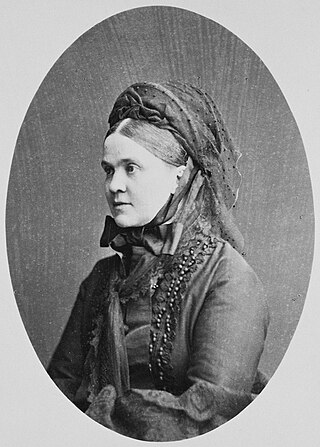
Adelaide of Löwenstein-Wertheim-Rosenberg was the wife of the deposed king Miguel I of Portugal. As a widow, she secured advantageous marriages for their six daughters.

The Order of Queen Saint Isabel is a Roman Catholic dynastic order of which the Grand Mistress is the Duchess of Braganza.

The coat of arms of the present-day German free state of Saxony shows a tenfold horizontally-partitioned field of black (sable) and gold/yellow (or) stripes, charged with a green (vert) crancelin running from the viewer's top-left to bottom-right. Although the crancelin is sometimes shown bent (embowed) like a crown, this is due to artistic license. The coat of arms is also displayed on the state flag of Saxony.
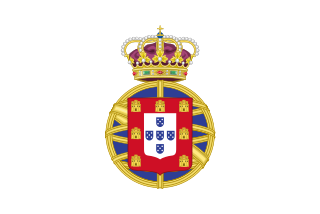
The Kingdom of Brazil was a constituent kingdom of the United Kingdom of Portugal, Brazil, and the Algarves.

In the history of Portugal, a Miguelist was a supporter of the legitimacy of the king Miguel I of Portugal. The name is also given to those who supported absolutism as form of government, in opposition to the liberals who intended the establishment of a constitutional regime in Portugal.

Princess Maria Theresa of Löwenstein-Wertheim-Rosenberg was a Princess of Löwenstein-Wertheim-Rosenberg and a member of the House of Löwenstein-Wertheim-Rosenberg by birth and an Infanta of Portugal, Duchess consort of Braganza, and titular queen consort of Portugal through her marriage to Miguel Januário, Duke of Braganza, Miguelist claimant to the throne of Portugal from 1866 to 1920.
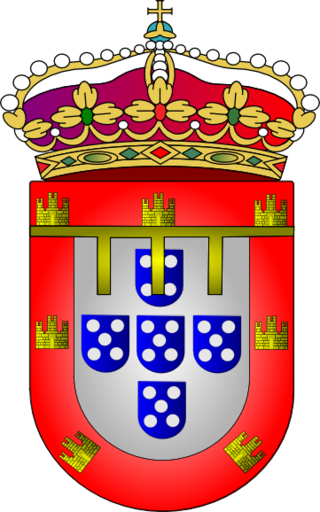
This is a list of Princesses Royal of Portugal. The title is, since 1815, carried either in her own right by the heiress to the throne, as a substantive title, or by the wife of the heir to the throne, the Prince Royal of Portugal, as a courtesy title. It was preceded by the titles Princess of Brazil and Princess of Portugal.

The Portuguese nobility was a social class enshrined in the laws of the Kingdom of Portugal with specific privileges, prerogatives, obligations and regulations. The nobility ranked immediately after royalty and was itself subdivided into a number of subcategories which included the titled nobility and nobility of blood at the top and civic nobility at the bottom, encompassing a small, but not insignificant proportion of Portugal's citizenry.

The Pantheon of the House of Braganza, also known as the Pantheon of the Braganzas, is the final resting place for many of the members of the House of Braganza, located in the Monastery of São Vicente de Fora in the Alfama district of Lisbon, Portugal. The pantheon's burials have included Portuguese monarchs, Brazilian monarchs, a Romanian monarch, queen consorts of Portugal, and notable Infantes of Portugal, among others.
Isabella, Isabel, Elizabeth or Elisabeth of Braganza may refer to:
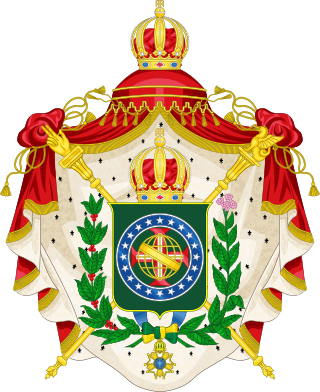
Brazilian heraldry as a distinct form of heraldry dates to 1822, when Brazil became independent as an Empire, under the reign of the House of Braganza. Being formerly a part of the Portuguese Empire and being ruled by the same Royal House that reigned in Portugal, Brazilian heraldry followed the tradition of Portuguese heraldry.





































